Last updated: October 26, 2021
Article
The Glacier Bay Marine Environment
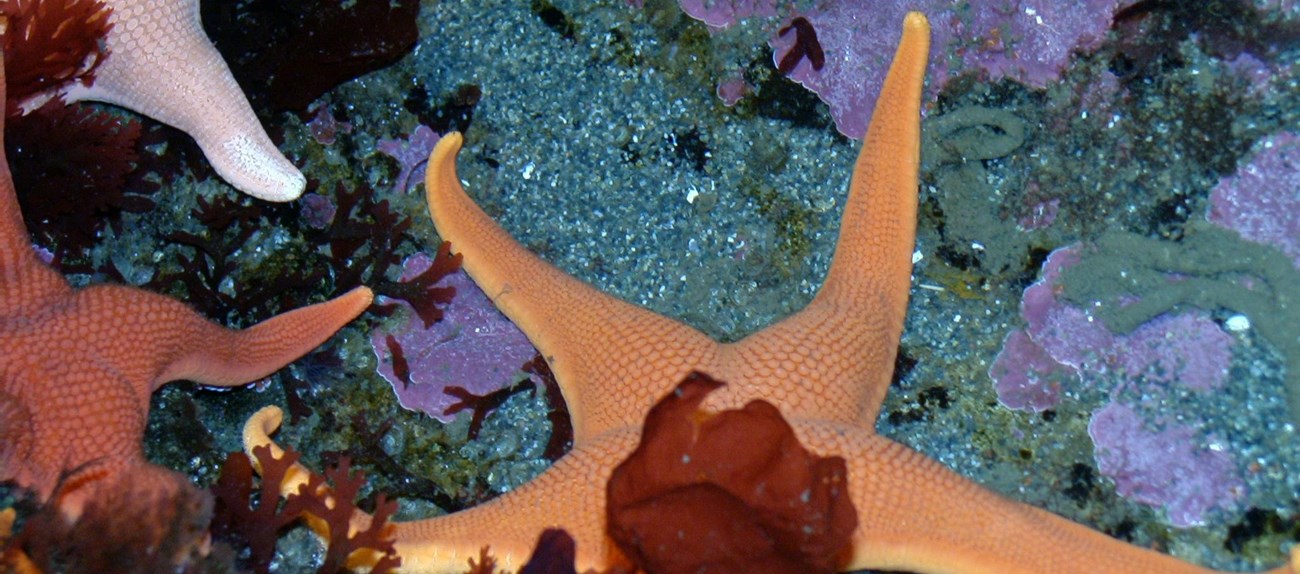
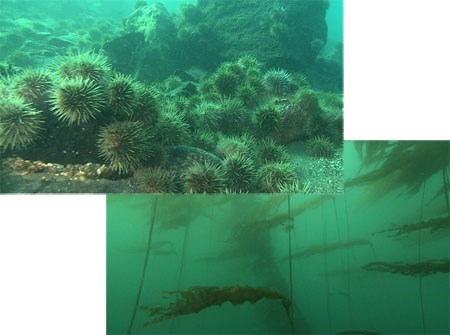
THE OCEAN ENVIRONMENT
Glacier Bay contains a very complicated oceanographic system within a relatively small area. This complexity is one of the reasons why such an unusual variety of marine life is found here. The bay is a network of large, U-shaped valleys that, once, were filled by glaciers but now are flooded by the ocean and fed by streams and rivers. As the glaciers retreated, the ocean invaded the bay, creating a wide array of underwater environments, often with overlapping biological communities. These communities are part of a huge, complex and extremely productive marine food web, which is affected by the nutrients available, the water temperature and its salinity, and the topography of the ocean floor.
The bulk of this marine productivity is driven by countless billions of tiny plant-like creatures - called phytoplankton - that float suspended in a shallow band of water mainly in the Middle Bay where sunlight can penetrate. The phytoplankton are too small to be seen with the naked eye. Glacier Bay supports incredibly dense populations of phytoplankton that last throughout the spring, summer, and fall.
Nutrients
In ocean water, nutrients include nitrogen, phosphorus, carbon, sulfur — "any inorganic or organic solute necessary for the nutrition and growth of phytoplankton." Created by the decomposition of dead organisms that sink to the ocean floor, nutrients are taken to the surface by turbulence and vertical mixing where they are used by phytoplankton for their growth and, their reproduction. Then, through the unending process of life that includes death and decay, they make their way again to the ocean depths. Biological productivity is also dependent upon sufficient light to enable phytoplankton to photosynthesize, and water column stability so the plankton can remain in the light near the surface.
Temperature
The surface water is warmer than the waters below it, and the water temperature changes, particularly as the seasons change. The water's inhabitants are most productive in the temperature range best suited for them for growth and reproduction.
Salinity
Salinity is the measure of how much salt is in water and its concentrations vary based on the area and the depth of the water. Salinity is usually highest at depths where temperature is the lowest because heavier water sinks. It is lowest at this latitude in the warmer surface waters and is changeable by precipitation and evaporation. Under the surface, the water salinity changes only with mixing. In estuaries, the freshwater of rivers and streams dilutes the salinity of the ocean water, thus affecting the distribution of fish, thereby altering how seabirds feed.
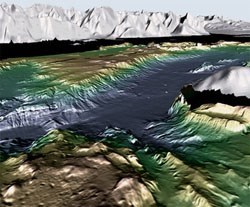
Bathymetry
The shape of the land beneath the ocean's surface varies, just as does above the surface. The ocean's bathymetry, or the contours of the ocean's floor, can reveal valleys, hills, mountains and plains. How it is shaped determines the way the water flows and how it is mixed, which affects the water's salinity and temperature and, thus, its inhabitants. Where "deep ocean currents hit a shallow shelf on the ocean floor, all the cold, deep water is forced upwards... [bringing] high concentrations of nutrients" to the surface. This mixing supplies food in abundance to fish, seabirds and mammals. Glacier Bay's perfect balance of stratification in the water column and mixing allows the constant addition of nutrients from the depths while keeping phytoplankton in the photic zone. This is the key to the productivity of the marine system in the Bay. The mixing agent in Glacier Bay is the tides, which work in combination with the bottom topography.
Light
Two other factors are necessary to translate nutrients into productivity: enough light for plant plankton, called phytoplankton, to photosynthesize rapidly, and enough water column stability to allow these tiny organisms to stay in the zone of light near the surface. All these factors come together in spring and early summer.
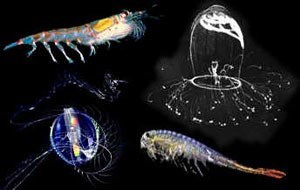
WHO LIVES THERE?
The marine environment is home to many species, including plankton (animal and plant), fish and shellfish, seabirds, and marine mammals, such as sea otters. These species are interdependent, that is, they depend on each other for their continued survival. In this community are plants that make their own food (producers) and animals that eat those plants and other animals (consumers).
Phytoplankton
Phytoplankton are producers. They are microscopic, chlorophyll-containing plants that use the sun's energy to make their food (photosynthesis). Under the proper spring and summertime conditions of sunlight, water column stability and nutrient availabity, phytoplankton can grow and reproduce rapidly. This phenomenon is called a bloom and can last for hour or even months. These blooms support other animal life as well.
Zooplankton
Zooplankton are small invertebrates that live suspended in the water-column, feeding on phytoplankton. Some examples of zooplankton include krill, larval fish, protozoans and jellyfish. Several zooplankton species "time" their reproduction to take advantage of phytoplankton blooms in the spring and early summer. Fish prey on zooplankton and, then, are preyed upon by larger fish, birds and mammals, such as sea lions and whales.
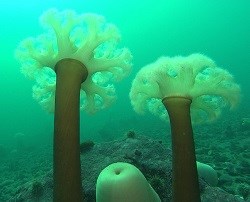
Vegetation
Seaweeds and salt-marsh vegetation begin growing in early spring. At low tide, these are fed upon by birds like geese and even mountain goats and, at high tide, by snails. When the vegetation decomposes, it sinks to the bottom as detritus and becomes food for worms, sand fleas, barnacles, anemones and clams. Kelp species in Glacier Bay include bull kelp and giant kelp, which grow in large kelp forests.
Fish and Other Sea Animals
Many different animal species live in Glacier Bay. More than 200 species of fish are represented, including five species of Pacific salmon, pollock, Pacific halibut and rockfish. Also present are crabs, clams, shrimp and scallops. The intertidal zone houses other kinds of sea life - barnacles, sea cucumbers, sea urchins and mussels.
Seabirds
Seabirds prey on the life on top of and just under the surface of the sea. In Glacier Bay National Park, thousands of the birds make their homes on the cliffs and shore rocks. Species include terns, puffins, gulls and jaegers.
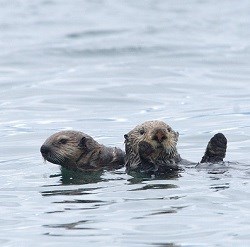
Marine Mammals
Mammals also make their homes in these waters because of the availability of abundant food. Humpback, minke and orca whales feed here, as do porpoises, sea lions and the harbor seals that breed and care for their young on the ice floes.
Also at home are the sea otters, who can be found in the shallow waters, on the rocky shores and in the tidal estuaries. Sea otters are considered a keystone species, an indicator of the health of the near shore ecosystem. In particular, they are depended upon to keep the sea urchin populations in check because, when their growth is out of control, the urchins decimate the kelp forests. Kelp forests not only act as fish nurseries, they provide shelter and are foraging grounds for other sea life, and act as shelter against severe winter storms.
SEASONAL CHANGES
While the output of phytoplankton and other vegetation explodes in the spring and early summer, other marine life also follow seasonal changes. Herring and cod release their eggs into the abundant plankton while skates "produce large yolk-rich eggs" from energy stored earlier. This is also the time when marine birds and mammals put on fat to last through the lean times. Summer doesn't last long and, when winter begins to take hold, several species migrate southward. Most of the remaining species slow down, rest, and wait for the spring.
